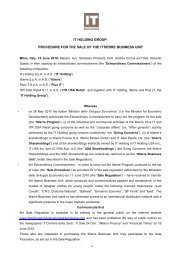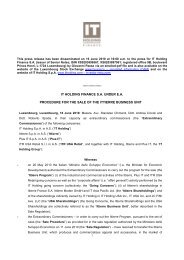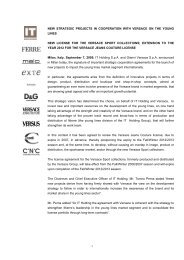Create successful ePaper yourself
Turn your PDF publications into a flip-book with our unique Google optimized e-Paper software.
<strong>IT</strong> HOLDING S.p.A. Notes to the consolidated financial statements for the year ended December 31, 2003<br />
Negative goodwill arising on acquisition represents the excess of the fair value of the net identifiable assets acquired<br />
over the cost of acquisition. To the extent that negative goodwill relates to an expectation of future losses and<br />
expenses that are identified in the plan of acquisition and can be measured reliably, but which have not yet been<br />
recognized, it is recognized in the income statement when the future losses and expenses are recognized. Any<br />
remaining negative goodwill, but not exceeding the fair value of the non-monetary assets acquired, is recognized in<br />
the income statement over the weighted average useful life of those assets that are depreciable/amortizable. Negative<br />
goodwill in excess of the fair values of the non-monetary assets acquired is recognized immediately in the income<br />
statement.<br />
Commercial goodwill paid for the group’s sales premises is included into goodwill. It is amortized on the basis of the<br />
duration of the lease contracts; where necessary carrying amounts are written down by the amount not expected to be<br />
recovered through future revenues or sale.<br />
Licenses, trademarks and permits<br />
Acquired trademarks licenses and permits are stated at cost or at the attributed value at the date of the acquisition less<br />
accumulated amortization and impairment losses.<br />
Research and development expenditure<br />
Expenditure on research activities, undertaken with the prospect of gaining new scientific or technical knowledge and<br />
understanding is recognized in the income statement as an expense as incurred.<br />
Investment in collection development of all models and samples included into the catalogue of the new collection is<br />
capitalized if the amount will be recoverable on the basis of the future economic benefit generated by the new<br />
collection. The investment capitalized includes the cost of materials, and direct labour. Other development<br />
expenditure is recognized in the income statement as an expense as incurred. Investment in collection development is<br />
stated at cost less accumulated amortization and impairment losses.<br />
Investments in collection development are amortized on a systematic basis following the expected path of future<br />
economic benefits expected to flow to the company (i.e. on the basis of the rate of the revenues accounted for at year<br />
end over the total expected revenues from the sale of the collection, represented by the orders collected). The path of<br />
future economic benefits related to this investment is generally expected to be realised within twelve months.<br />
Other intangible assets<br />
Other intangible assets and deferred charges expected to benefit future periods are recorded at cost less accumulated<br />
amortization and impairment losses.<br />
Subsequent expenditure<br />
Subsequent expenditure on capitalized intangible assets is capitalized only when it increases the future economic<br />
benefits embodied in the specific asset to which it relates. All other expenditure is expensed as incurred.<br />
Amortization<br />
Amortization is calculated on a straight-line basis over the estimated useful lives of intangible assets. Goodwill is<br />
amortised from the date of initial recognition; other intangible assets are amortized from the date they are available for<br />
use.<br />
The applicable amortization periods are as follows:<br />
goodwill 20 years<br />
patents and trademarks 20 years<br />
development costs generally 1 year<br />
other intangible assets generally 5 years<br />
Inventories<br />
Inventories are stated at the lower of purchase or production cost and net realizable value. Net realizable value is the<br />
estimated selling price in the ordinary course of business, less the estimated costs of completion and selling expenses.<br />
F- 51






